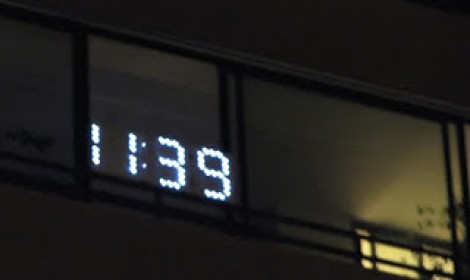
[Rod] is in a position to provide a community service on New Year’s Eve. He spends the evening at a relative’s house next to the beach. There are fireworks at midnight, but the crowd has no communal way to count down to the deadline. This year, he build his own count-down display so that everyone can join in during the last few seconds.
This is a temporary build so each digit is housed in a cardboard box. [Rod] first drew the outline of the seven segment digit on the front, then added holes for three LEDs in each segment. He’s feeding the segments with 12V and therefore is able to run the LEDs in series, along with a resistor, switching each segment with one transistor. He chose an Arduino to drive the display, and since he had two sitting around, used both instead of grabbing a shift register as port expander.
If you’re looking for a more permanent solution, we really like the digit displays designed for this scoreboard. But you’re going to have to etch the boards yourself if you want them done in time for the festivities.















Cool, run it up a flag pole and make a ball too!
I just switch my VFD tube clock to ‘milliseconds until midnight’ mode, thanks to Jason von Nieda’s awesome firmware.
Other than that, I cue up Strange Days so that midnight in the movie coincides with midnight. These are my New Year’s rituals.
meh
Before anyone jumps on me I should clarify why this is so meh.
He uses 2 arduinos cause he has them lying around rather than some 595s(this is already pretty meh)
He’s using transistors to sink 16mA per pin, which is well within the spec of a 328, I think they can handle slightly over 40mA (fair enough you wouldn’t want it sinking 280mA) but 112mA is fine.
Will his superbrights even be that bright at 16mA? Depends on the particular LED and what superbright means.
It’s lazy and wasteful.
I used shift registers and one 328 for a fully disposable finished project. Two arduinos served very well at the prototyping stage.
You are right about the transistors. I used them in case the 3-led were not as visible and I needed to add two or more to each segment. But it turned out to work OK. And yes, lazy was in the original concept: I wanted the hardware to take me less than one day of building, which it did.
Don’t get me wrong it’s a perfectly fine project.
Crafting the display out of cardboard is done really, really well. Much neater than I could.
But without code( I couldn’t find any) and the fact it’d cost well over £50 for parts (2x arduino + ethernet shield) and then add an RTC module, 80 odd super bright LEDS…. and whatever else, when it could be done much cheaper and efficiently.
Idk, is it really HaD worthy?
Are you? :)
Instead of looking at how it was done – look at what it’s doing instead.
This is a service to many people that is used once a year. It ticks of many boxes such as: quickly made and high service value.
I really can’t see how it could be made any better? A project like this doesn’t need ordered components or a fabricated enclosure.
It needs to be quick and dirty and make as many people happy as possible. If anything, ordering extra shift registers and timers would have been wasteful. It’s a once a year project and his time is valuable.
Is it HaD worthy? I believe this is more worthy than the tons of featured projects that are well made, but never really serves a purpose other than “because i can”.
// :)
I don’t know either. I really hacked those boxes and I did it in one day. It looks like the simple sort of projects I like to read about here in HaD. I had all of the parts already, except for the LEDs. That said, the cost of this project was exactly USD22.
He mentions that he has a clock so that people know it’s there…. I like clocks, so I don’t wanna just be a pooper, but there’s still time to think about the design before New Years. I’d want to make it count down for the entire hour so that people not only know it’s there, but mentally register that it counts down (not up like a normal clock) and that it’s capable of reporting seconds, so they know that they need to pay attention to it later. As a viewer I wouldn’t assume it would do a countdown in the last minute since clocks don’t typically do that, and so they may not look at it. Although, if one person sees it counting down in the last 60s, word may spread quickly on a beach.
Those are valid concerns… but only time will tell.
I can *very happily* report that this project accomplished the task very well. It is so lightweight that it took me less than five minutes to hang it from the balcony using nylon thread.
When the time came I joined the crowd and I could see plenty of people watching at the clock and pointing out “hey, cool there’s a clock up there”.
And finally I went back to where the clock was.
When the last minute came, everyone was instinctively looking at the countdown timer: My family and I were able to witness literally three hundred people counting down in unison to 2012 thanks to this simple timer. The NTP sync RTC I used kept accuracy to way less than a second offset with the IPad I had for time accuracy reference. Amazing result, even better than I expected. I definitely want to thank the HaD readers who support other peoples projects. Happy New Year everyone!
Great job!